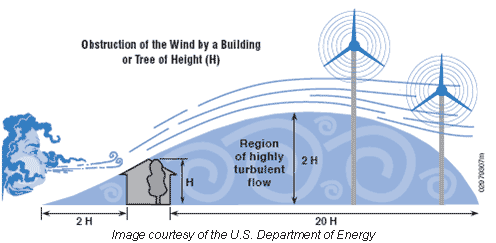small wind turbine siting

To find the best site on your property for your small wind turbine, you have a lot to consider. A professional wind turbine dealer or installer should help you find the best location.
Wind resource considerations
You can have varied wind resources within the same property. In addition to measuring or finding out about the annual wind speeds, you need to know about the prevailing directions of the wind at your site.
If you live in complex terrain, take care in selecting the installation site. If you site your wind turbine on the top of or on the windy side of a hill, for example, you will have more access to prevailing winds than in a gully or on the leeward (sheltered) side of a hill on the same property.
In addition to geological formations, you need to consider existing obstacles, such as trees, houses, and sheds. You also need to plan for future obstructions, such as new buildings or trees that have not reached their full height. Your turbine needs to be sited upwind of any buildings and trees, and it needs to be 30 feet above anything within 300 feet.
System considerations
Be sure to leave enough room to raise and lower the tower for maintenance. If your tower is guyed, you must allow room for the guy wires.
Whether the system is stand-alone or grid-connected, you also will need to take the length of the wire run between the turbine and the load (house, batteries, water pumps, etc.) into consideration. A substantial amount of electricity can be lost as a result of the wire resistance – the longer the wire run, the more electricity is lost. Using more or larger wire will also increase your installation cost.
Your wire run losses are greater when you have direct current (DC) instead of alternating current (AC). If you have a long wire run, it is advisable to invert DC to AC.
